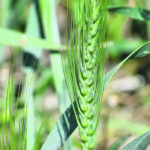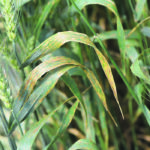Normally in a dry year, disease is not a major concern for cereal growers in Western Canada. But an emerging disease did cause issues for a number of growers in Alberta. “Bacterial leaf streak was a significant problem in many irrigated areas of southern Alberta in 2021,” said Mike Harding, a plant pathologist with Alberta […] Read more
Tag Archives crop disease

Prairie farmers warned about bacterial leaf streak
The cereal disease is just emerging as a problem to pay attention to in Western Canada, but it is well-established in other parts of the world
Plant pathologists in Western Canada are continuing to learn more about bacterial leaf streak (BLS), an emerging cereal leaf disease that can reduce wheat yields by 40 to 50 percent in severely infected fields. Mike Harding, a research scientist and plant disease expert with Alberta Agriculture, said confirmed cases of the disease are still relatively […] Read more
Scout now for fusarium
Conditions could be ripe for fusarium head blight across large swathes of Manitoba and Saskatchewan. Recent rain, high humidity and warm daytime temperatures may have increased the risk of the disease in many fields of winter and spring wheat. It’s also a combination of high levels of inoculums carried over from last year in relation […] Read more

Fusarium expected to be problem this year
High levels of the disease last year mean farmers have to watch what they seed and pay close attention to the weather
Fusarium pressure was high in last year’s prairie wheat crop, and that doesn’t bode well for this year. “With all this disease from last year, the land is now reinoculated for 2017,” said Holly Gelech of BioVision Seed Labs. “Those nodes hold a massive amount of spores … and they are going to impact the […] Read more
Elusive resistance
Farmers need to take fusarium head blight resistance ratings with a grain of salt, according to research out of Manitoba Agriculture. The research shows that varieties can perform much differently in the real world than they did in the variety registration trials where they received the official rating that is published in the provincial seed […] Read more

Video: Sowing seeds of crop destruction
MORDEN, Man. — Bob Conner sounds like a proud papa when he shows off a patch of withered, wilting, dying bean plants. “This is our white mould nursery,” he explained to a group of bean growers, agronomists, advisers and agriculture researchers. “We will be irrigating if we have to…. We want to create the ideal […] Read more

Now is the time to keep a sharp eye out for ergot
When the final tally is in, this crop year is likely to show up as wetter than most years on the Prairies, and that’s just what fungus likes. Ergot is no exception, and true to form, it has shown up in some cereal and hay fields. In addition to affecting yield and increasing dockage, ergot […] Read more

‘Big 5’ threaten canola
There are 10 to 15 diseases that can affect canola, says crop pathologist Ron Howard. There are also non-disease threats and environmental factors that can cause symptoms in canola that mimic disease. “Don’t jump to conclusions,” Howard told a July 28 Lethbridge plot tour organized by the Farming Smarter research group. “There’s a whole other […] Read more

Blackleg growing along with canola
Southern Manitoba’s canola crop is off to a good start because of a wet spring. However, the moist conditions have also prompted growers to load up their sprayers with fungicide for blackleg. “It’s everywhere, and we know that there is a level of pressure and a level of the disease that we’re probably going to […] Read more

Verticillium stripe causes concern
The Canadian canola industry has been concerned about verticillium stripe ever since the plant disease was found in Manitoba in 2014 because high infection rates will significantly reduce yields. Soil surveys conducted by the Canadian Food Inspection Agency last year found the disease in Saskatchewan, Manitoba, British Columbia, Ontario and Quebec. Barbara Ziesman, Saskatchewan’s provincial […] Read more




